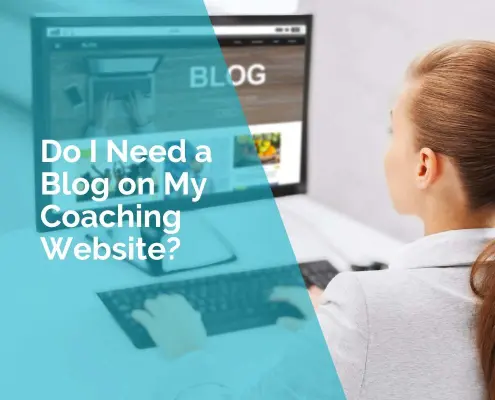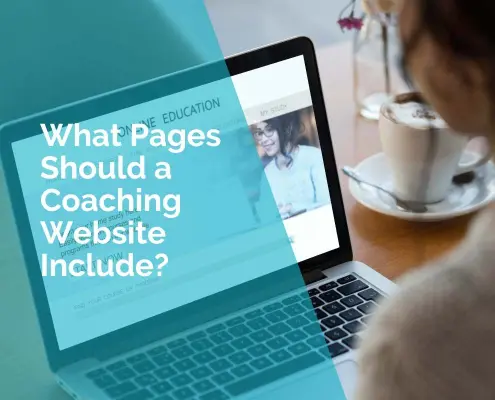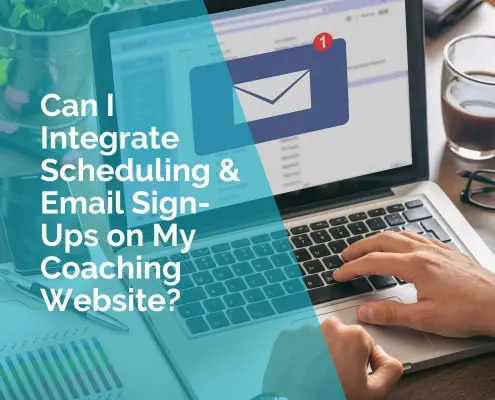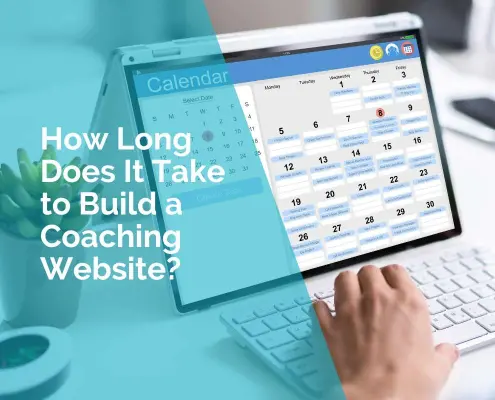Can I Integrate Scheduling and Email Sign‑Ups on My Coaching Website?
Yes – and you absolutely should. Modern coaching websites can embed online scheduling and email sign‑ups so visitors can book a call and join your list in a few clicks. On WordPress, tools like Calendly or Acuity connect seamlessly with email platforms such as GetResponse, MailerLite, or ConvertKit – giving you automated confirmations, reminders, and nurturing sequences with very little ongoing admin.
Why scheduling + email integration matters for coaches
Every extra click costs you conversions. When someone lands on your site and can instantly book a discovery call or subscribe for a useful resource, you reduce friction and increase momentum. Done well, these integrations deliver three compounding benefits:
- Less admin — Automate confirmations, reminders, reschedules, follow‑ups, and even basic intake.
- More qualified leads — Turn casual visitors into subscribers with on‑page forms and focused lead magnets.
- Higher conversion rates — Clear next steps on each page prevent decision fatigue and build trust quickly.
If you’re still designing your site’s foundations, pair these integrations with the basics covered in Essential Website Features for Coaches and the messaging tips in Transform Your Coaching Website Content.
What “integration” looks like on a WordPress coaching site
There are three common ways to connect your stack — each with different levels of control and complexity:
- Embed widgets — Paste a short code snippet from your scheduling/email platform into a page block. Fastest to launch; minimal development work; styling usually controlled by the tool.
- Official plugins — Install the provider’s WordPress plugin for deeper options (GDPR consent, styling controls, hidden fields, spam protection, event tracking).
- API/automation links — Use native integrations, webhooks, or lightweight automation to push data between systems (e.g., “New booking → tag in email platform”). Best for advanced segmenting and multi‑step funnels.
Most coaches start with an embedded scheduler + email plugin, then layer on API automations once the funnel is proven.
Choosing tools that fit your coaching business
Scheduling options
- Calendly — Quick setup, clean UI, Google/Outlook sync, Zoom links, round‑robin team options, simple intake questions.
- Acuity Scheduling — Great for packages, buffers, prep time, and flexible availability; powerful custom intake forms.
- SimplyBook.me — Useful if you run classes, group sessions, or memberships with varied resources.
- Book Like a Boss — “All‑in‑one” booking pages with upsells, basic payments, and straightforward configuration.
Email & marketing automation
- GetResponse — All‑in‑one email, automation, landing pages, and webinars — ideal when you want event funnels and simple list growth under one roof.
- MailerLite — Beginner‑friendly with forms, pop‑ups, and simple automations; good balance of features and cost.
- ConvertKit — Strong tagging/segmenting and commerce features; created with coaches/creators in mind.
- ActiveCampaign — Deeper automation + CRM when you need complex logic, pipelines, and advanced scoring.
Tip: Choose the simplest stack that meets today’s needs and can scale later. Over‑engineering on day one slows launch and doesn’t increase bookings.
Placement & UX: where these elements should live
- Primary CTA — Put “Book a Discovery Call” in your header menu and hero section. Reinforce the same action in your page sections.
- Inline booking — Embed your scheduler on the Contact/Work With Me page so people don’t bounce to a separate site.
- Focused lead magnet — Add an email form within relevant articles and on a dedicated landing page; keep the promise tight and valuable.
- Footer form — Capture late‑stage readers who scroll for details — a short form works well here.
- Thank‑you pages — After booking or subscribing, confirm next steps and present a relevant resource or micro‑offer.
Consistent, low‑friction pathways help visitors progress without confusion. For copy guidance, see Transform Your Coaching Website Content.
Automation that saves hours (and increases conversions)
Once your tools are connected, line up these lightweight automations:
- New subscriber → welcome series — Deliver the lead magnet instantly, followed by 3–5 short emails that build trust and invite a call.
- New booking → confirmations & reminders — Email + calendar invites; optional SMS reminders reduce no‑shows.
- No‑show → rebook prompt — A friendly 2‑email follow‑up with a one‑click rebook link.
- Post‑call → next step — Send a short summary + link to your packages page or proposal.
Keep emails short, benefit‑led, and skimmable. Aim for clarity over cleverness — friction kills momentum.
Case study (anonymised): consolidating with GetResponse
Background: A career transition coach was juggling separate tools for sign‑ups, newsletters, and webinar registrations. Leads were slipping through cracks, and follow‑up timing was inconsistent.
What we did: We consolidated her email marketing into GetResponse and embedded two simple on‑site flows:
- A lead magnet sign‑up offering a concise “Career Change Roadmap” — placed on relevant blog posts and a tidy landing page.
- An embedded booking widget on the Work With Me page, synced to her calendar with a handful of smart intake questions.
Inside GetResponse, we created a short welcome sequence and a webinar sign‑up funnel with automated reminders. The result was a steadier stream of qualified discovery calls, fuller webinar attendance, and far less manual admin — without increasing her weekly workload.
Implementation: step‑by‑step on WordPress
- Decide the primary action — on each page, is the main goal “Book a Call” or “Get the Guide”? Choose one primary CTA.
- Prepare assets — availability and call descriptions for scheduling; a compact lead magnet and a 4–5 email welcome series for sign‑ups.
- Install + connect — embed the scheduler; add your email platform’s plugin or HTML form; connect to your lists and tags.
- Map the automations — new subscriber → welcome series; new booking → confirmations and reminders; no‑show → rebook sequence.
- Place CTAs consistently — header, hero, within sections, and footer. Keep wording consistent across buttons and pages.
- Test on mobile — complete a booking and a sign‑up yourself; verify timings, links, and calendar events.
- Launch, then measure — track bookings, sign‑ups, and conversion rate per page; optimise with small tests.
Performance first: keep embeds fast
Embeds and plugins add scripts — which can slow your pages if you’re not careful. Protect site speed by:
- Using one scheduler and one email platform (avoid duplicate pop‑ups).
- Loading pop‑ups on intent (scroll, time, or exit), not on page load.
- Compressing images, enabling caching, and deferring non‑critical scripts.
- Testing Core Web Vitals; replace heavy widgets with native forms if needed.

Want this set up the right way?
We build WordPress sites for coaches with friction‑free booking and high‑converting sign‑ups. Explore our Website Design for Coaches & Consultants service and book a strategy session.
Consent, trust, and good data hygiene
High‑quality lists convert better and keep your reputation strong. Best practices include:
- Explain what subscribers will receive and how often — set clear expectations.
- Include a consent checkbox where required and link to your privacy policy.
- Use double opt‑in for lead magnets or webinars if list quality is a concern.
- Tag contacts by source (guide vs webinar vs contact form) to send relevant follow‑ups.
Measure what matters (and improve over time)
Data turns guesses into confident decisions. Track:
- Booking conversion rate — bookings ÷ unique visitors on your booking page.
- Sign‑up conversion rate — sign‑ups ÷ unique visitors on your lead magnet landing page.
- Welcome series engagement — opens, clicks, and replies in the first 7–10 days.
- Time‑to‑call — average days from first visit to booking (lower is better).
Run simple A/B tests — shorter vs longer forms, alternate headlines for your lead magnet, or “Book a Call” vs “Get the Roadmap” in specific contexts. Incremental gains compound month over month.
Common pitfalls (and how to avoid them)
- Too many CTAs — one page, one primary action. Secondary links can sit in the footer.
- Long forms — ask for the minimum you need to start a conversation; you can qualify later.
- Inconsistent copy — if a button promises a call, the next page should confirm a call — not ask people to email you.
- “Set and forget” funnels — review sequences quarterly; update screenshots, offers, and timing.
Pre‑launch QA checklist
- Booking widget works on mobile and desktop; time zones display correctly.
- Confirmation/reminder emails include the right links, times, and calendar invites.
- Lead magnet delivers instantly; thank‑you page sets expectations and next steps.
- Welcome series sends in the intended order; every link works.
- Analytics and goals are set for bookings and sign‑ups.
Advanced funnels (add when the basics are working)
- Webinar funnel — registration → reminders → live/session replay → discovery‑call invitation.
- Quiz funnel — short diagnostic quiz → tailored result → segmented follow‑up and booking CTA.
- Tripwire offer — small paid resource post‑signup to qualify buyers and fund ad spend.
- Retargeting — show ads to recent visitors promoting your lead magnet or booking page.
Only add complexity after your primary flow (book a call or download the guide) consistently converts. The fastest path to bookings is usually the simplest.
Troubleshooting common issues
- Low booking rate — reduce choices on the booking page, clarify the value of the call, and surface social proof near the CTA.
- Poor sign‑up rate — tighten the lead magnet promise, remove non‑essential fields, and test a more specific headline.
- No‑shows — add a 24‑hour reminder + “what to prepare” checklist; offer easy rescheduling.
- Slow site — trim duplicate pop‑ups, defer third‑party scripts, compress images, switch heavy widgets to native forms.
When to hire help (and what to ask)
If you value speed, clean execution, and reliable tracking, bring in a specialist. When you speak with a designer or implementer, ask:
- Which scheduling/email tools do you recommend for coaches at my stage?
- How will you protect site speed with embeds and scripts?
- Will you set up analytics goals for bookings and sign‑ups?
- Do you provide a simple playbook for updating forms and sequences?
- What’s included post‑launch — bug fixes, small updates, and optimisation advice?
If you want a done‑for‑you option, explore our Website Design for Coaches & Consultants service — we handle strategy, build, integrations, and tracking so you can stay focused on clients.
Where this fits in your bigger plan
Scheduling and email sign‑ups are the spine of your client engine — but they perform best when the surrounding content and structure are strong. For context and next steps:
- How Much Does a Coaching Website Cost? — budget realistically for build and integrations.
- How Long Does It Take to Build a Coaching Website? — plan timelines and avoid delays.
- Essential Website Features for Coaches — make sure the foundations support your goals.
Frequently Asked Questions
Can I integrate both scheduling and email sign-ups on my coaching website?
Yes – most modern website platforms and tools allow you to combine scheduling features with email list sign-ups for a seamless user experience.
Integrating scheduling and email sign-ups means visitors can book a session with you and join your email list in one smooth process. This setup not only saves you time but also ensures that every new booking is captured for ongoing marketing. With the right tools – such as WordPress combined with plugins like Amelia, Bookly, or Calendly, and an email service like GetResponse – you can automate confirmation emails, follow-up sequences, and even send reminders without lifting a finger.
What tools can I use to set up scheduling and email sign-ups together?
Popular options include Calendly, Acuity Scheduling, Amelia, Bookly, and integrations with email platforms like GetResponse, ConvertKit, or MailerLite.
The best tool for you depends on your website platform and business workflow. For WordPress, plugins like Amelia or Bookly offer direct integration with email marketing services, allowing you to automatically add clients to your mailing list. If you prefer standalone apps, tools like Calendly or Acuity Scheduling can be linked to email platforms via Zapier or built-in integrations. These setups ensure that once a client books, they’re also added to your list for nurturing and follow-up.
Will integrating scheduling and email sign-ups improve my client bookings?
Yes – it reduces friction and encourages more clients to take action in one visit.
When you combine scheduling and email sign-ups, you create a streamlined process that makes it easy for prospects to commit. Instead of filling out multiple forms or clicking through several pages, they can take both actions at once. This convenience improves user experience and often increases conversion rates. It also gives you permission to stay in touch, which can lead to repeat bookings and referrals.
How do I make sure my scheduling and email sign-ups are GDPR and privacy compliant?
Always use a clear consent checkbox and link to your privacy policy.
Compliance isn’t optional — especially if you serve clients in regions with strict privacy laws. Make sure your booking and sign-up forms clearly explain how their information will be used. Include an unchecked opt-in box for joining your mailing list and link to your privacy policy. Many tools, including GetResponse and Calendly, have built-in GDPR-friendly features to help you collect consent correctly.
Can I track where my bookings and email sign-ups are coming from?
Yes – use built-in analytics, Google Analytics, or your email platform’s tracking features.
Tracking sign-up sources helps you see which marketing channels are driving the most results. You can set up tracking links in your booking tool, add UTM parameters for Google Analytics, or review your email platform’s reports. This data helps you refine your marketing strategy, invest in the right channels, and optimise the booking process for even better results.
 Ivana Katz from Websites 4 Small Business is an award winning web designer who builds websites that build your business. She provides unbeatable web design services to fit your budget.
Ivana Katz from Websites 4 Small Business is an award winning web designer who builds websites that build your business. She provides unbeatable web design services to fit your budget.
The end result? Professional, custom-made sites that give your business the extra oomph it needs to stand out from the competition and make an impact.
Whether you’re a brand-new business or an established one ready to improve your digital presence, Ivana makes it easy to get your business online very quickly. Her websites are professional, tailored to fit your budget, and give your business a serious boost.
Download your FREE copy of “Ultimate Website Design Secrets Blackbook – 10 Bulletproof Strategies for Designing an Outrageously Successful Website”











